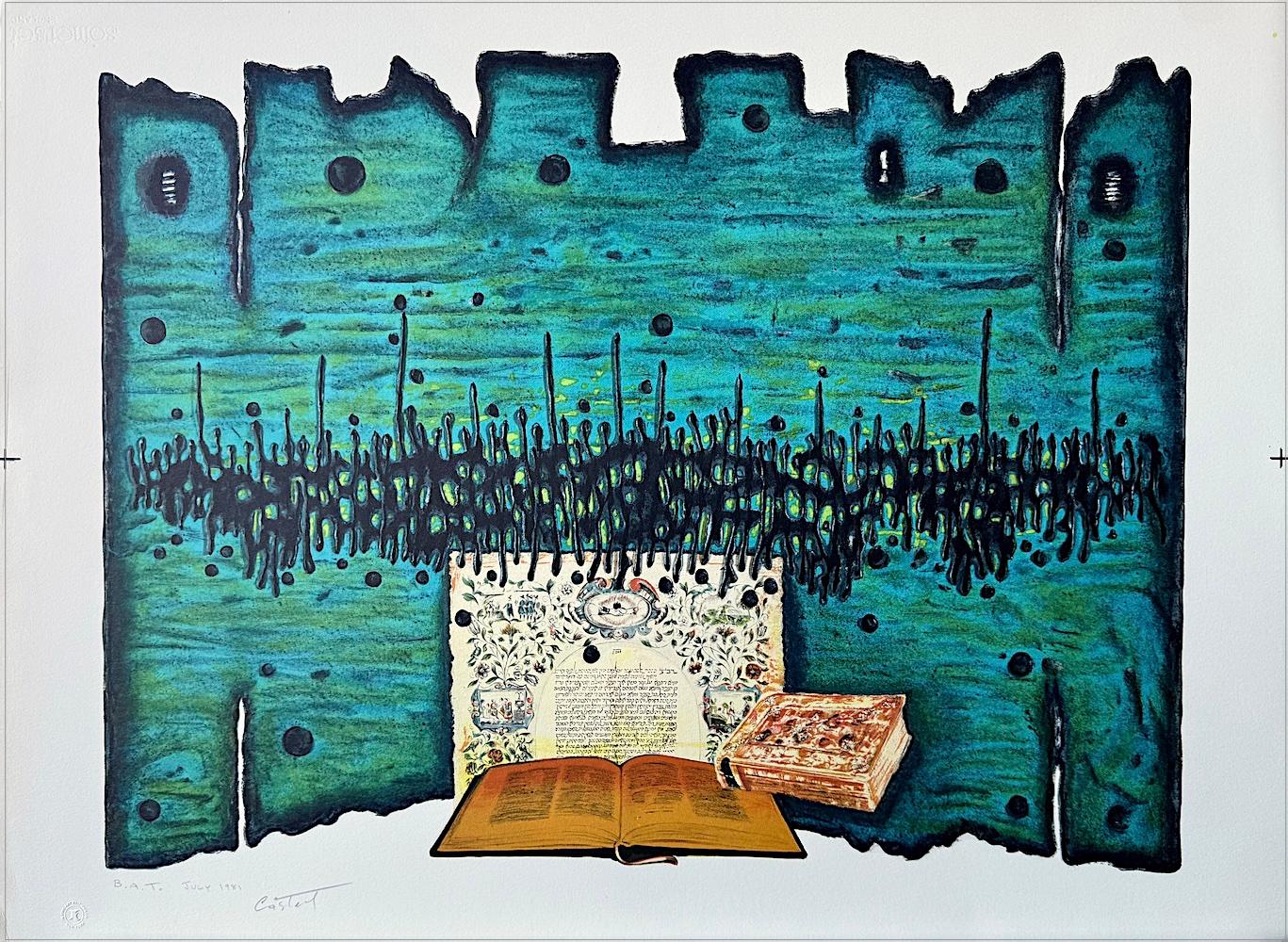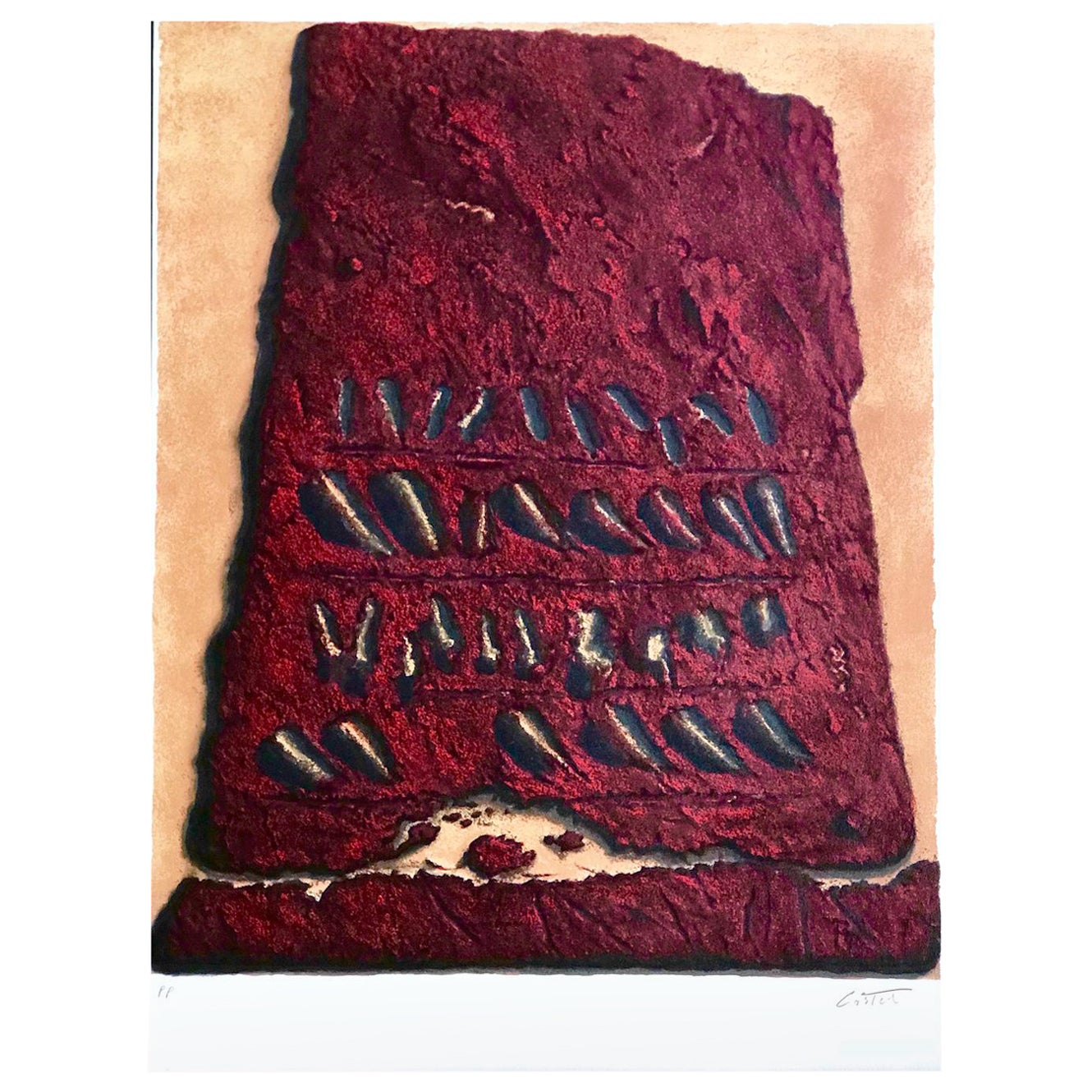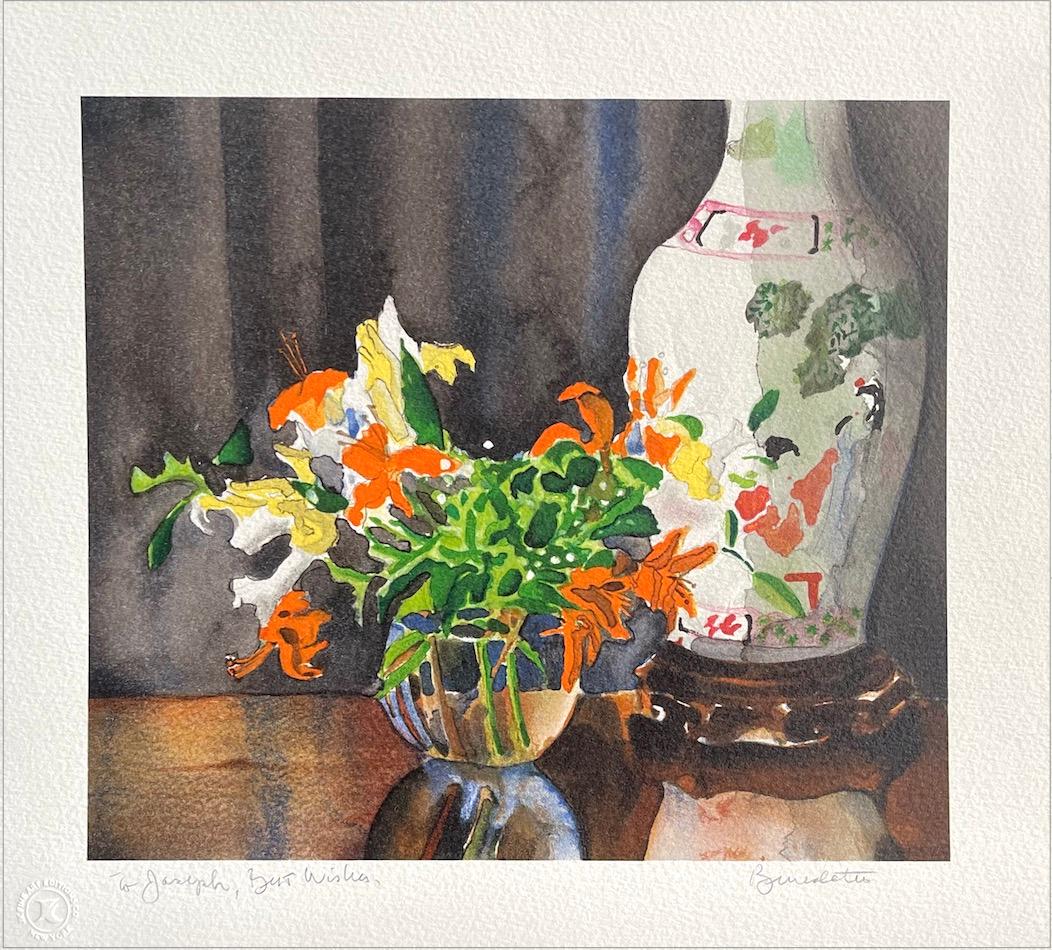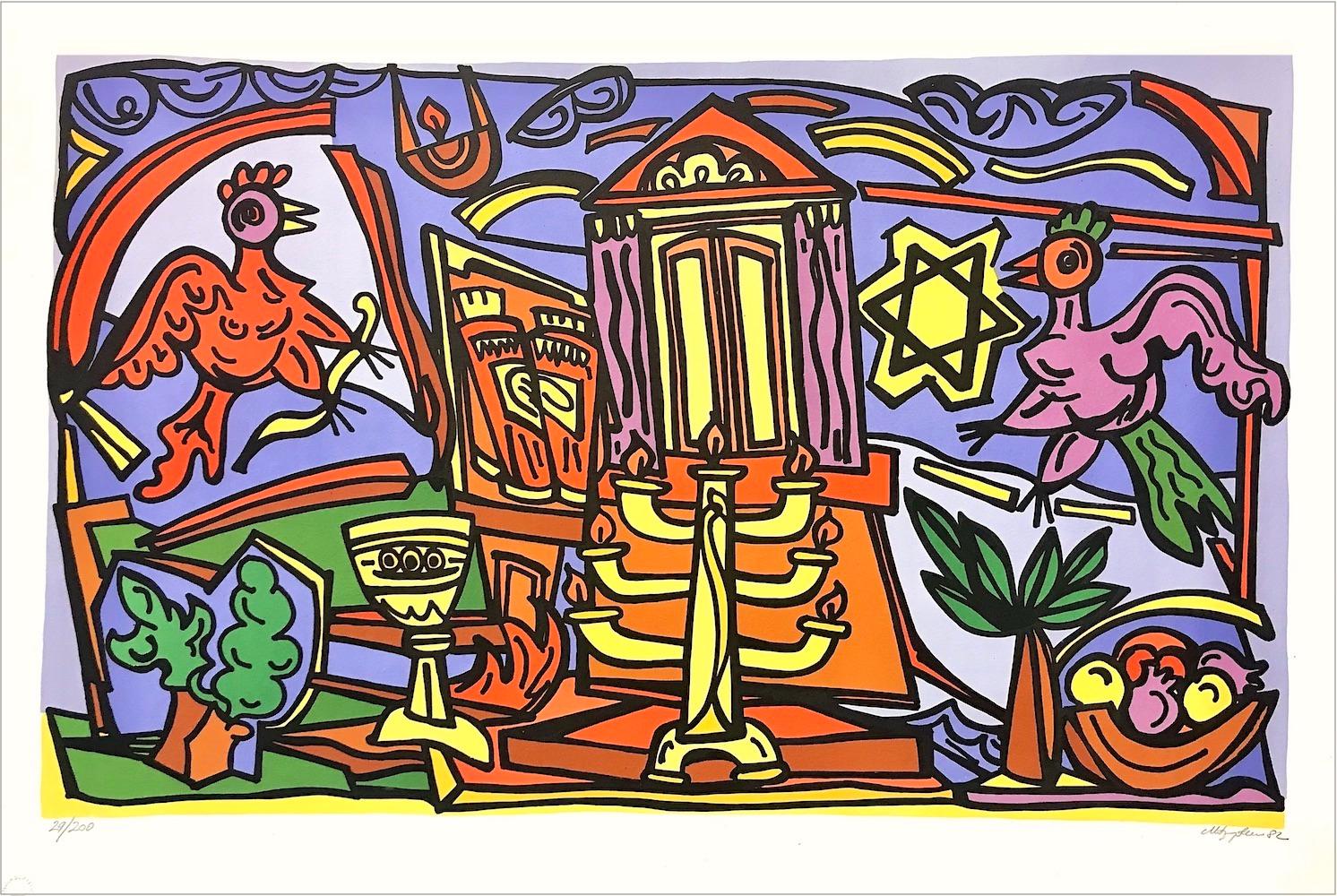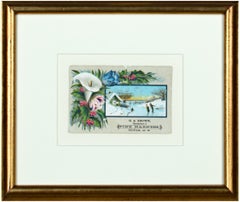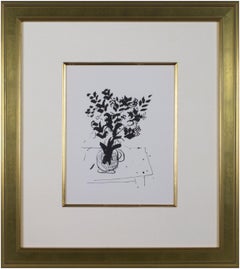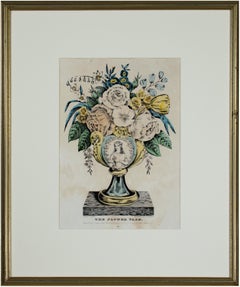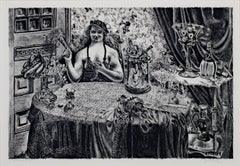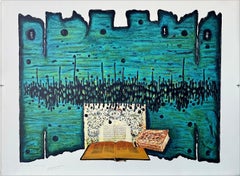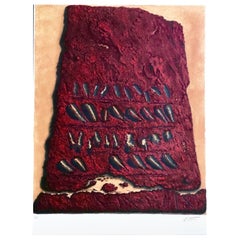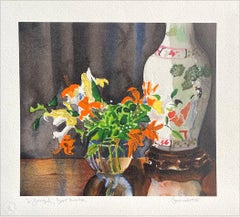Items Similar to "Bodegon - Still Life: Apple, Pear, & Funnel in Box, " Original Color Lithograph
Want more images or videos?
Request additional images or videos from the seller
1 of 9
Armando Morales"Bodegon - Still Life: Apple, Pear, & Funnel in Box, " Original Color Lithograph1980
1980
About the Item
"Bodegon - Still Life: Apple, Pear & Funnel in Box" is an original color lithograph by Armando Morales. The artist signed the piece and this piece is the presentation proof for the edition.
22 1/2" x 30 3/16" art
32 1/8" x 39 7/8" frame
Armando Morales was born in Granada, Nicaragua on January 15, 1927, the youngest of six children of a family deeply rooted in religion. Two years later, the family moved to Managua, the Capital, where there were greater opportunities for his father to expand his hardware business.
Since Early childhood Armando showed a great interest in art. Morales’ skill for drawing did not go unnoticed by his teachers. One of them in particular, who taught arithmetic, grammar and painting, frequently praised his paintings while turning a blind eye to his laziness in other subjects. By this time, painting ceased to be only a school activity: He also painted at home on his return from school. Around 1938, he painted realistically some imaginary landscapes with Morales regards as the true beginning of his artistic career.
The School of Fine Arts of Managua had a rigorous academic curriculum. The first year was dedicated to drawing with charcoal, and later with crayon, inanimate models of wood and plaster, as well as all kinds of cloth. Perspective, history of art and anatomy was taught during the second year and, while still working with crayon and charcoal, live models were introduced. It was not until the third year that Morales would fulfill his childhood dreams of painting in oils.
In 1956, he participated in the Central American Painting Contest “15 de Septiembre” held in Guatemala and won first prize with his painting Spook-Tree. This painting was later bought buy the Museum of Modern Art in New York. In 1957, the exhibition “Six Nicaraguan Artists” was inaugurated in Washington. Morales Received excellent reviews and sold all the paintings with which he had participated.
In 1970 he painted lush and sensual fruits, heavy and voluptuous apple and pears that evoked the softness of human skin, from which there was the obvious transition to the painting of nudes. In his 1971 Exhibition at the Galeria Bonino in New York, he showed a series of stunning nudes; the fine detail of every muscle, every inch of skin revealing an unsurpassed sensuality.
In 1977, he returned to the work of lithographs, having made several editions in New York and Berlin. He produced a series in black & white for Herbert Kassner of Lithographic Editions at the Kryon Editions Workshop Mexico City.
In 1993, he completed a portfolio of lithographs entitled The Saga of Sandino at the workshop of Artegrafias Limitadas, S.A. in Mexico City. Sandino was a Nicaraguan national hero whom Morales remembered seeing in Managua during his childhood. While in Mexico City, he also finished a portrait of Gabriel Garcia Marquez. A year later, the lithographs were exhibited at the Rufino Tamayo Museum in Mexico City and at the Institute of Graphic Arts in Oaxaca, where Morales also Held a conference on the occasion of the exhibition. He then went to Guadalajara for the inauguration of the Julio Cartazar Chair at the University of Jalisco. He was also Appointed juror for the Exposicion Pinturerias organized by the Cultural Foundation Artencion, Mexico City.
- Creator:Armando Morales (1927, Nicaraguan)
- Creation Year:1980
- Dimensions:Height: 32.125 in (81.6 cm)Width: 39.875 in (101.29 cm)
- Medium:
- Movement & Style:
- Period:
- Condition:
- Gallery Location:Milwaukee, WI
- Reference Number:Seller: 1558d1stDibs: LU60532527881
About the Seller
4.9
Gold Seller
Premium sellers maintaining a 4.3+ rating and 24-hour response times
Established in 1966
1stDibs seller since 2017
429 sales on 1stDibs
Typical response time: 2 hours
- ShippingRetrieving quote...Shipping from: Milwaukee, WI
- Return Policy
Authenticity Guarantee
In the unlikely event there’s an issue with an item’s authenticity, contact us within 1 year for a full refund. DetailsMoney-Back Guarantee
If your item is not as described, is damaged in transit, or does not arrive, contact us within 7 days for a full refund. Details24-Hour Cancellation
You have a 24-hour grace period in which to reconsider your purchase, with no questions asked.Vetted Professional Sellers
Our world-class sellers must adhere to strict standards for service and quality, maintaining the integrity of our listings.Price-Match Guarantee
If you find that a seller listed the same item for a lower price elsewhere, we’ll match it.Trusted Global Delivery
Our best-in-class carrier network provides specialized shipping options worldwide, including custom delivery.More From This Seller
View AllOriginal Victorian card with flower arrangement and ice skating scene
Located in Milwaukee, WI
Business cards like this fall into the category of what art historians today generally refer to as "ephemera." Ones like this were produced for companies in the late 19th century, pr...
Category
1890s Romantic Still-life Prints
Materials
Lithograph
Black and White Bouquet in Vase on Table, Marc Chagall lithograph
By Marc Chagall
Located in Milwaukee, WI
6 x 6.5 inches, image
14.88 x 11 inches, paper
22.63 x 20.13 inches, frame
Offset lithograph after the original drawing
Framed to conservation standards using 100 percent silk-lined rag matting and museum glass, housed in a gold cassetta-style moulding with a gilded fillet insert
Marc Chagall was born in Liozno, near Vitebsk, now in Belarus, the eldest of nine children in a close-knit Jewish family led by his father Khatskl (Zakhar) Shagal, a herring merchant, and his mother, Feige-Ite. This period of his life, described as happy though impoverished, appears in references throughout Chagall's work. The family home on Pokrovskaya Street is now the Marc Chagall Museum...
Category
1970s Modern Still-life Prints
Materials
Lithograph
19th century color lithograph still life vase flowers
By Nathaniel Currier
Located in Milwaukee, WI
The present hand-colored lithograph is one of several decorative images of flower-filled vases published by Nathaniel Currier. This example contains roses, tulips, forget-me-nots, and others all within a vase with gold eagle head handles and an image of a beautiful young woman the belly.
16 x 11 inches, artwork
22.5 x 18.25 inches, frame
Entitled bottom center
Signed in the stone, lower left "Lith. and Pub. by N. Currier"
Inscribed lower right "152 Nassau St. Cor. of Spruce N.Y."
Copyrighted bottom center "Entered according to Act of Congress in the year 1848 by N. Currier in the Clerk's office of the Southern District of N.Y." with the number 249
Framed to conservation standards using 100 percent rag matting, housed in a lemon gold moulding.
Nathaniel Currier was a tall introspective man with a melancholy nature. He could captivate people with his piercing stare or charm them with his sparkling blue eyes. Nathaniel was born in Roxbury, Massachusetts on March 27th, 1813, the second of four children. His parents, Nathaniel and Hannah Currier, were distant cousins who lived a humble yet spartan life. When Nathaniel was eight years old, tragedy struck. Nathaniel’s father unexpectedly passed away leaving Nathaniel and his eleven-year-old brother Lorenzo to provide for the family. In addition to their mother, Nathaniel and Lorenzo had to care for six-year-old sister Elizabeth and two-year-old brother Charles. Nathaniel worked a series of odd jobs to support the family, and at fifteen, he started what would become a life-long career when he apprenticed in the Boston lithography shop of William and John Pendleton.
A Bavarian gentleman named Alois Senefelder invented lithography just 30 years prior to young Nat Currier’s apprenticeship. While under the employ of the brothers Pendleton, Nat was taught the art of lithography by the firm’s chief printer, a French national named Dubois, who brought the lithography trade to America.
Lithography involves grinding a piece of limestone flat and smooth then drawing in mirror image on the stone with a special grease pencil. After the image is completed, the stone is etched with a solution of aqua fortis leaving the greased areas in slight relief. Water is then used to wet the stone and greased-ink is rolled onto the raised areas. Since grease and water do not mix, the greased-ink is repelled by the moisture on the stone and clings to the original grease pencil lines. The stone is then placed in a press and used as a printing block to impart black on white images to paper.
In 1833, now twenty-years old and an accomplished lithographer, Nat Currier left Boston and moved to Philadelphia to do contract work for M.E.D. Brown, a noted engraver and printer. With the promise of good money, Currier hired on to help Brown prepare lithographic stones of scientific images for the American Journal of Sciences and Arts. When Nat completed the contract work in 1834, he traveled to New York City to work once again for his mentor John Pendleton, who was now operating his own shop located at 137 Broadway. Soon after the reunion, Pendleton expressed an interest in returning to Boston and offered to sell his print shop to Currier. Young Nat did not have the financial resources to buy the shop, but being the resourceful type he found another local printer by the name of Stodart. Together they bought Pendleton’s business.
The firm ‘Currier & Stodart’ specialized in "job" printing. They produced many different types of printed items, most notably music manuscripts for local publishers. By 1835, Stodart was frustrated that the business was not making enough money and he ended the partnership, taking his investment with him. With little more than some lithographic stones, and a talent for his trade, twenty-two year old Nat Currier set up shop in a temporary office at 1 Wall Street in New York City. He named his new enterprise ‘N. Currier, Lithographer’
Nathaniel continued as a job printer and duplicated everything from music sheets to architectural plans. He experimented with portraits, disaster scenes and memorial prints, and any thing that he could sell to the public from tables in front of his shop. During 1835 he produced a disaster print Ruins of the Planter's Hotel, New Orleans, which fell at two O’clock on the Morning of the 15th of May 1835, burying 50 persons, 40 of whom Escaped with their Lives. The public had a thirst for newsworthy events, and newspapers of the day did not include pictures. By producing this print, Nat gave the public a new way to “see” the news. The print sold reasonably well, an important fact that was not lost on Currier.
Nat met and married Eliza Farnsworth in 1840. He also produced a print that same year titled Awful Conflagration of the Steamboat Lexington in Long Island Sound on Monday Evening, January 18, 1840, by which melancholy occurrence over One Hundred Persons Perished. This print sold out very quickly, and Currier was approached by an enterprising publication who contracted him to print a single sheet addition of their paper, the New York Sun. This single page paper is presumed to be the first illustrated newspaper ever published.
The success of the Lexington print launched his career nationally and put him in a position to finally lift his family up. In 1841, Nat and Eliza had their first child, a son they named Edward West Currier. That same year Nat hired his twenty-one year old brother Charles and taught him the lithography trade, he also hired his artistically inclined brother Lorenzo to travel out west and make sketches of the new frontier as material for future prints. Charles worked for the firm on and off over the years, and invented a new type of lithographic crayon which he patented and named the Crayola. Lorenzo continued selling sketches to Nat for the next few years.
In 1843, Nat and Eliza had a daughter, Eliza West Currier, but tragedy struck in early 1847 when their young daughter died from a prolonged illness. Nat and Eliza were grief stricken, and Eliza, driven by despair, gave up on life and passed away just four months after her daughter’s death.
The subject of Nat Currier’s artwork changed following the death of his wife and daughter, and he produced many memorial prints and sentimental prints during the late 1840s. The memorial prints generally depicted grief stricken families posed by gravestones (the stones were left blank so the purchasers could fill in the names of the dearly departed). The sentimental prints usually depicted idealized portraits of women and children, titled with popular Christian names of the day.
Late in 1847, Nat Currier married Lura Ormsbee, a friend of the family. Lura was a self-sufficient woman, and she immediately set out to help Nat raise six-year-old Edward and get their house in order. In 1849, Lura delivered a son, Walter Black Currier, but fate dealt them a blow when young Walter died one year later. While Nat and Lura were grieving the loss of their new son, word came from San Francisco that Nat’s brother Lorenzo had also passed away from a brief illness. Nat sank deeper into his natural quiet melancholy. Friends stopped by to console the couple, and Lura began to set an extra place at their table for these unexpected guests. She continued this tradition throughout their lives.
In 1852, Charles introduced a friend, James Merritt Ives, to Nat and suggested he hire him as a bookkeeper. Jim Ives was a native New Yorker born in 1824 and raised on the grounds of Bellevue Hospital where his father was employed as superintendent. Jim was a self-trained artist and professional bookkeeper. He was also a plump and jovial man, presenting the exact opposite image of his new boss.
Jim Ives met Charles Currier through Caroline Clark, the object of Jim’s affection. Caroline’s sister Elizabeth was married to Charles, and Caroline was a close friend of the Currier family. Jim eventually proposed marriage to Caroline and solicited an introduction to Nat Currier, through Charles, in hopes of securing a more stable income to support his future wife.
Ives quickly set out to improve and modernize his new employer’s bookkeeping methods. He reorganized the firm’s sizable inventory, and used his artistic skills to streamline the firm’s production methods. By 1857, Nathaniel had become so dependent on Jims’ skills and initiative that he offered him a full partnership in the firm and appointed him general manager. The two men chose the name ‘Currier & Ives’ for the new partnership, and became close friends.
Currier & Ives produced their prints in a building at 33 Spruce Street where they occupied the third, fourth and fifth floors. The third floor was devoted to the hand operated printing presses that were built by Nat's cousin, Cyrus Currier, at his shop Cyrus Currier & Sons in Newark, NJ. The fourth floor found the artists, lithographers and the stone grinders at work. The fifth floor housed the coloring department, and was one of the earliest production lines in the country. The colorists were generally immigrant girls, mostly German, who came to America with some formal artistic training. Each colorist was responsible for adding a single color to a print. As a colorist finished applying their color, the print was passed down the line to the next colorist to add their color. The colorists worked from a master print displayed above their table, which showed where the proper colors were to be placed. At the end of the table was a touch up artist who checked the prints for quality, touching-in areas that may have been missed as it passed down the line. During the Civil War, demand for prints became so great that coloring stencils were developed to speed up production.
Although most Currier & Ives prints were colored in house, some were sent out to contract artists. The rate Currier & Ives paid these artists for coloring work was one dollar per one hundred small folios (a penny a print) and one dollar per one dozen large folios. Currier & Ives also offered uncolored prints to dealers, with instructions (included on the price list) on how to 'prepare the prints for coloring.' In addition, schools could order uncolored prints from the firm’s catalogue to use in their painting classes.
Nathaniel Currier and James Merritt Ives attracted a wide circle of friends during their years in business. Some of their more famous acquaintances included Horace Greeley, Phineas T. Barnum, and the outspoken abolitionists Rev. Henry Ward, and John Greenleaf Whittier (the latter being a cousin of Mr. Currier).
Nat Currier and Jim Ives described their business as "Publishers of Cheap and Popular Pictures" and produced many categories of prints. These included Disaster Scenes, Sentimental Images, Sports, Humor, Hunting Scenes, Politics, Religion, City and Rural Scenes, Trains, Ships, Fire Fighters, Famous Race Horses, Historical Portraits, and just about any other topic that satisfied the general public's taste. In all, the firm produced in excess of 7500 different titles, totaling over one million prints produced from 1835 to 1907.
Nat Currier retired in 1880, and signed over his share of the firm to his son Edward. Nat died eight years later at his summer home 'Lion’s Gate' in Amesbury, Massachusetts. Jim Ives remained active in the firm until his death in 1895, when his share of the firm passed to his eldest son, Chauncey.
In 1902, faced will failing health from the ravages of Tuberculosis, Edward Currier sold his share of the firm to Chauncey Ives...
Category
1840s Romantic Still-life Prints
Materials
Watercolor, Lithograph
"Victoria" original lithograph signed by Malvin Marr "Zsissly" Albright
By Malvin Marr Albright
Located in Milwaukee, WI
The present print, "Victoria," is the most iconic example of the printmaking of Malvin Marr Albright, called Zsissly. The composition for the image comes from Albright's painting from about 1935, done while he was studying at the Art Institute of Chicago. We can see clearly in the image how he possesses the same skill for unsettling, magic realist images as his more famous twin brother Ivan Le Lorraine: The lady Victoria sits at a dining room table, surrounded by luxurious still-life objects. All the textures and surfaces of the image express a horror vacui as seen in his painted works, such as "The Trail of Time is Dust" at the Pennsylvania Academy of Fine Art. The door in this print recalls one of the more famous works by his brother, "That Which I Should Have Done I Did Not Do (The Door)" at the Art Institute of Chicago.
1947, after ca. 1935 original painting
8 1/2 x 13 inches, image
12 x 16 inches, sheet
16 1/4 x 20 1/2 frame
Signed in pencil, lower right
Title in pencil, lower left
Published by Associated American Artists Inc.
Unnumbered from the edition of 250
A painter and sculptor, Malvin Albright was born in Chicago, one of twin sons of Adam Emory Albright, famous Chicago figure painter of juvenile subjects, who often used Malvin and his brother Ivan Le Lorraine as models.
Malvin's middle name, Marr, was after Wisconsin artist Carl von Marr...
Category
1940s American Modern Figurative Prints
Materials
Lithograph
'Lobsterman's Wharf, Maine' original lithograph signed by "Zsissly" Albright
By Malvin Marr Albright
Located in Milwaukee, WI
'Lobsterman's Wharf, Maine' is an original lithograph signed by Malvin Marr "Zsissly" Albright. While Malvin Marr – along with his better-known identical twin Ivan Albright – was known for his meticulous and unsettling magic realist compositions, he and his brother were also prolific in capturing landscapes of the coast of Maine where the two spent several consecutive summers away from Chicago over their lives. Sometimes these Maine landscapes and views would be painterly and seemingly antithetical to the careful realism of his other work; but in this example, however, the wharf is treated with the same macabre decay as his human subjects. In the composition, the shack...
Category
1940s American Modern Figurative Prints
Materials
Lithograph
"La Peine Perdue (The Wasted Effort)" Lithograph after Painting by Rene Magritte
By René Magritte
Located in Milwaukee, WI
"La Peine Perdue (The Wasted Effort)" is a color lithograph after original 1962 painting by Rene Magritte. Two blue curtains are parted on either side. Two curtain shaped mirrors show a sky and clouds. A ball sits right to the left of the mirrors.
Art: 12 x 9.75 in
Frame: 22.75 x 20.38 in
René-François-Ghislain Magritte was born November 21, 1898, in Lessines, Belgium and died on August 15, 1967 in Brussels. He is one of the most important surrealist artists. Through his art, Magritte creates humor and mystery with juxtapositions and shocking irregularities. Some of his hallmark motifs include the bourgeois “little man,” bowler hats, apples, hidden faces, and contradictory texts.
René Magritte’s father was a tailor and his mother was a miller. Tragedy struck Magritte’s life when his mother committed suicide when he was only fourteen. Magritte and his two brothers were thereafter raised by their grandmother.
Magritte studied at the Brussels Academy of Fine Arts from 1916 to 1918. After graduating he worked as a wallpaper designer and in advertisement. It was during this period that he married Georgette Berger, whom he had known since they were teenagers.
In 1926, René Magritte signed...
Category
2010s Surrealist Still-life Prints
Materials
Lithograph
You May Also Like
PRAYER Signed Lithograph, Holy Books, Turquoise, Gold Yellow, Black, Jewish Art
By Moshe Castel
Located in Union City, NJ
PRAYER by the Israeli artist Moshe Castel (1909-1991) is a limited edition lithograph printed in 14 colors using traditional lithographic techniques on archival Somerset paper 100% a...
Category
1980s Contemporary Still-life Prints
Materials
Lithograph
SECRET WRITINGS Signed Lithograph, Ancient Script, Red Stone Tablet
By Moshe Castel
Located in Union City, NJ
SECRET WRITING by the Israeli artist Moshe Castel (1909-1991) is a hand drawn, limited edition lithograph printed in 12 colors using traditional hand lithography techniques on archival Somerset paper 100% acid free. In SECRET WRITING, a three dimensional relief 3D effect is visible in the black writings and textural ancient stone tablet...
Category
1980s Contemporary Still-life Prints
Materials
Lithograph
VIENNESE STILL LIFE Trompe l'Oeil Lithograph, Arts and Crafts Style, Music, Fan
Located in Union City, NJ
Anne Lloyd’s VIENNESE STILL LIFE is a hand drawn limited edition lithograph printed using hand lithography techniques on archival printmaking paper 100% aci...
Category
1980s Contemporary Still-life Prints
Materials
Lithograph
CHINESE VASE Signed Lithograph, Interior Still Life, Orange Flowers
By Tony Bennett
Located in Union City, NJ
CHINESE VASE is a hand drawn limited edition lithograph by the renowned American jazz and traditional pop singer Tony Bennett. CHINESE VASE, an interior still life scene depicting lilies in a round glass vase and a figurative Chinese porcelain vase, was printed using hand lithography techniques on archival Arches printmaking paper. Eye-appealing colors of orange, yellow, green, brown, blue, dark gray, touches of black and white.
Print size - 9.75 x 10.75 in., unframed, pristine condition, dedicated Printers Proof hand signed in pencil "Benedetto" by Tony Bennett on lower margin
Image size - 8.5 x 7.5 in.
Printer - JK Fine Art Editions Co.
Publisher - Eleanor Ettinger Gallery NY
Anthony Dominick “Tony” Benedetto (1926-2023), Tony Bennett, a world-renowned singer and performer, was also an accomplished visual artist whose subjects span nearly every topic. Working under his birth name of Anthony Benedetto, he utilized watercolors, oil paints, charcoal, or whatever else was handy to depict his chosen theme. Benedetto's artistic career began at the age of five with sidewalk chalk drawings outside his childhood home in Astoria Queens...
Category
1990s Contemporary Still-life Prints
Materials
Lithograph
JAPANESE AZALEAS Signed Lithograph, Watercolor Floral, Pink, Lavender, Green
By Glenny Brazy
Located in Union City, NJ
JAPANESE AZALEAS is an original hand drawn lithograph printed using hand lithography techniques on archival Arches paper 100% acid free. JAPANESE AZALEAS portrays a botanical waterco...
Category
1980s Contemporary Still-life Prints
Materials
Lithograph
JEWISH SYMBOLS Signed Lithograph, Modern Jewish Art, Menorah, Star, Roosters
By Marius Sznajderman
Located in Union City, NJ
JEWISH SYMBOLS is an original hand drawn, limited edition lithograph by Marius Sznajderman (Born-Paris, France 1926-2018) printed in colors on white archival printmaking paper, 100% acid-free, using traditional hand lithography printmaking methods. JEWISH SYMBOLS is an expressive modern abstract color still life composition depicting symbols from the Jewish faith including a menorah, roosters, Magen David(star), Aron Kodesh...
Category
1980s Contemporary Abstract Prints
Materials
Lithograph
